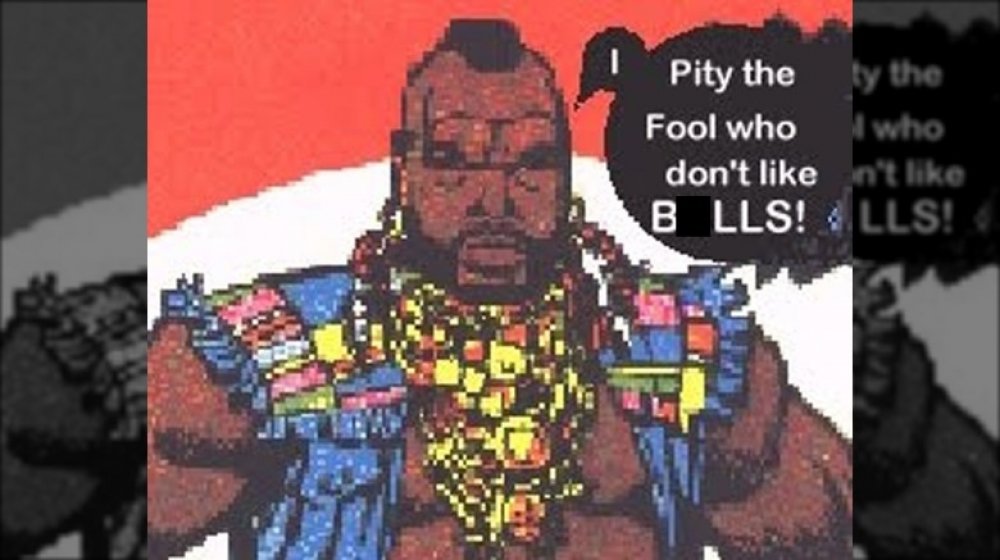The Oldest Memes On The Internet
When the internet was conceptualized, it was meant to be a way to transfer information rapidly across the globe. Now, just a few decades later, humanity got bored of that and spends a lot of its collective time on the internet sending other people memes. There are new ones popping up all the time, to the point that entire websites are dedicated to cataloging them.
But what about the earliest internet memes? What were the very first jokes that went viral on the web, shared by everyone's weird aunts in email forwards because social media and video sharing sites hadn't been invented yet?
Now that some time has gone by and the internet has officially been around longer than Circuit City and Blockbuster Video were, web historians can now point to the earliest memes, how they developed, and how they influenced the culture of the internet in weird and surprising ways.
A dancing baby with mainstream meme appeal
Even today, decades after its creation, internet culture crossing over into the world of mainstream entertainment is a pretty dicey prospect. Think of when TV crime shows try to explain web fads for their ripped-from-the-headlines stories. It's often awkward at best and downright cringeworthy at worst. It's not easy to go from one world to the other without a lot of work.
But one of the very first web memes managed it, albeit still in a pretty clunky manner. Sometimes credited as the first internet meme, the dancing baby animation is, well, a dancing baby. Originally a sample animation file for a 3D art program called Character Studio, the dancing baby started to proliferate throughout the internet in 1996 according to TechCrunch.
3D animation was still very new at the time. Toy Story and Sony's PlayStation had only come out the previous year, so it was still a bit of a novelty, which helped the dancing baby spread. But it also quickly gained recognition outside the internet as well, appearing in news broadcasts, commercials, and even a 1998 episode of Ally McBeal, where the title character hallucinated the baby. The dancing baby reached the cultural saturation point not long after, especially since, even in those two short years, 3D modeling and animation had already jumped leaps and bounds, which made the baby look very dated.
A sophomoric, baffling celebrity meme
Making fun of celebrities on the internet is basically one of the pillars of web comedy. After all, they're well-known, highly visible, and will probably never even notice it because they almost certainly have far better things to do. So celebrity memes are a thing, like Keanu Reeves sitting on a bench and looking sad, Gordon Ramsay yelling at people, or Robert Downey Jr. looking very annoyed. Let's not forget the early 2000s internet's obsession with Chuck Norris, too.
But before all of those was one that was frankly kind of weird. "Mr. T Ate My B*lls" was the world's first image-based meme, launching in 1996 after becoming a running joke at the University of Illinois Urbana/Champaign, according to The Ball Report. The premise is simple: Take a photo or illustration of A-Team star and 80s icon Mr. T, add a crude speech balloon, and write up something about how much he likes to consume reproductive organs. That's really it.
The odd, somewhat nonsensical meme took off, and some of the original sites collecting examples of it are still live today. Back when Yahoo was a web directory, they even had a whole section dedicated to it. Before long, other celebrities were also put into the meme format, like Chewbacca, Bart Simpson, and even Clinton impeachment independent counsel Kenneth Starr.
The most annoying site on the internet
Being as annoying as humanly possible, i.e., trolling, is now practically a national pastime. People still try to find new and unusual ways to Rickroll one another well over a decade after that meme first emerged. But in the period between the release of "Never Gonna Give You Up" and the start of the Rickrolling phenomenon, there was another way to irritate your friends and make them wish bodily harm upon you.
The Hamster Dance (also sometimes called "hampsterdance" due to the intentional misspelling of the word hamster in the site's address and on its front page) was a viral website launched around 1998, and it featured a sea of GIFs of dancing hamsters and other rodents (nearly 400, according to the CBC) and a looped audio clip of a song from Disney's Robin Hood sped up to a high pitch. It wasn't much, but the audio had an earworm quality to it that ensured anyone who listened to it would have it stuck in their head for a long time to come.
The site spread virally before anyone even used the term "viral" and became a bit of a phenomenon, with millions of visits to the site. The site even led to a series of chart-topping singles and albums featuring full-length songs based on the Robin Hood sample (originally titled "Whistle Stop") and numerous other Alvin and the Chipmunks-styled original songs.
A fish-man's warning to meme lovers
The early internet was a nerd's paradise, filled to bursting with references to the geekiest properties of the era, like Star Wars. References to the then nearly 20-year-old film, 1983's Return of the Jedi, were completely normal online, but something that would have been odd in the mainstream entertainment world.
So, in the early 2000s, appeared one of the first image macro style memes, where an image is overlaid with top and bottom text to humorous effect. Although it's difficult to pin down just when and where the meme began, it didn't take long for the "It's a trap!" meme to begin showing up in communities all over the internet.
Featuring a still image of Admiral Ackbar, a fish-like alien from Return of the Jedi, and referencing his most famous line, "It's a trap!" was used to humorously indicate when one might be walking into a situation for which they are unprepared, according to Film School Rejects. For example, the top text might say something like, "If your brain tells you you don't need to study for that big test..." followed by the bottom text, quoting Ackbar, "It's a trap!" So the internet became ground zero for warnings and everyday advice from a wise Rebel Alliance Admiral, who knew a trap when he saw one.
A silly text art helicopter becomes a meme
Nowadays, we have image searches, emojis, and numerous other ways to show off how we're feeling quickly. You might be familiar with emoticons, simple combinations of punctuation that vaguely look like human faces, which were a sort of precursor to emojis. These were but a tiny part of something known as ASCII art.
So named because the art was made from regular text characters that were part of the American Standard Code for Information Interchange, ASCII art was an early web artform that was easy to transmit because it was made up solely of text. Making elaborate drawings only out of text symbols became a sort of challenge. But the one that became the most notorious wasn't even a particularly elaborate one.
The "roflcopter" was a simple ASCII art helicopter, but the propellers were made up of the acronyms LOL and ROFL. According to Dictionary.com, it was originally created around 2003 by fans of Warcraft III, the third in the strategy game series that spawned World of Warcraft, and was based on the game's gyrocopter units. The ASCII art was made into a simple animated GIF and hosted on a dedicated site, roflcopter.com. The goofiness of the helicopter and its name caught fire and began popping up all over the internet. Roflcopter even became a synonym for LOL or ROFL, which helped it spread even further. You can still find references to it today.
The gleeful nonsense of a bad video game translation
In early video games, bad translations were simply something gamers had to put up with. Finishing a game to be rewarded with a screen saying something like, "A winner is you!" was fairly common, and there's no shortage of examples of similar translation errors.
But the 1992 Sega Mega Drive (called the Sega Genesis in America) release of an arcade game called Zero Wing was particularly notorious because the translation wasn't just bad, but hilariously awful. For the game's home release, developers added a cut scene not present in the arcade version, and the European release received the bizarre translation "All your base are belong to us," according to New York Magazine. It became an in-joke in gamer communities for several years, but what made the game famous to the internet at large was the rise of Adobe Flash animations.
A person using the name Bad_CRC took the cutscene, added a corny techno song, and used robotic text-to-speech voices to bring it to life in 2001. After a partial clip of the scene, the video then turns into a musical rendition of the song, sampling the robotic "All your base are belong to us" over and over along with dozens of Photoshopped images that included the phrase. The surreal video became one of the earliest video memes and soon had the whole internet saying lines like "Someone set up us the bomb," and "We get signal."
A Sesame Street character with a dark secret
Humans have a collective cultural fascination with the idea of something innocent turning out to be secretly evil. Clowns, dolls, and yes, children's television shows. How many times have you looked at something designed for kids and found it a bit chilling, or even downright creepy?
Sesame Street has largely been immune to this because its characters are pretty straightforward reflections of the real world. But a satirical website from 1997 called Bert is Evil joked that the show's most boring character (seriously, it's his whole deal) was a devious villain by inserting him into photos and stories of various tragedies.
It was fairly popular and new images cropped up all the time in response to events going on in the world. But things took a turn for the bizarre after September 11, 2001. A Reuters photographer in Bangladesh took a picture of a protest against Osama bin Laden and found something strange. One of the protest signs had a collage of photos, and in one of those, Bert stood next to bin Laden, according to writer Bill Meeks. The media was befuddled. The sign's creator had never seen the show and didn't know the significance of the little yellow Muppet, he just needed photos of bin Laden for his sign. The site's creator, in the midst of an international controversy, decided to take the site down, though numerous mirrors continue to exist even today.
A ridiculous line from a forgettable movie
2000's Finding Forrester is a drama about a reclusive writer (Sean Connery) in the vein of J.D. Salinger who tutors a young black student (Rob Brown). It's not very unique and borrows a lot from the dozens of similar films. It's not a terrible movie, though it has been criticized for heavily featuring the white savior trope. In one particular scene, Brown struggles with typing on Connery's old typewriter, and once he gets the hang of it, Connery shouts one of the goofiest lines in cinema history: "You're the man now, dog!"
Max Goldberg heard the line in a trailer for the film and instantly purchased yourethemannowdog.com, where he put a tiled photo of Connery, an audio loop of the line, and "YOU'RE THE MAN NOW DOG.COM" in large 3D text. It was a silly website for a silly line, but it quickly caught on and Goldberg received huge amounts of traffic, according to Gizmodo. By 2004, Goldberg had a new idea for what to do with the site.
He created a community he called YTMND (an acronym of Connery's line), where people could quickly and easily create their own similar pages, complete with a repeating background, looped audio, and oversized word art. This led to a storm of other silly sites, several of which became memes as well. YTMND was one of the web's earliest meme factories, though social media and video sharing sites eventually led to its demise.
A swarm of badgers got the meme treatment
In the late 90s and early 2000s, Adobe's Flash platform became the de facto format for web video and animations. It was relatively easy to use, and the resulting files were often small and easy for users to watch right in their browser, as opposed to downloadable videos, which typically had to be watched in a separate app and were often hefty downloads. Many Flash animations of the time were fairly crude, often made by people with little experience but funny ideas.
Jonti Picking, also known as Weebl, was an exception. Not only was he a talented animator and web designer, he was also adept at voice acting and songwriting, which led to his site, Weebl's Stuff, becoming a go-to place for funny web cartoons. Initially popular for his Weebl and Bob series, which featured two talking egg-like creatures who loved pie, in 2003, Picking created Badgers, which soon became one of the first viral internet animations.
Badgers was a looping animation with scenes of dancing badgers, a mushroom, and a snake, along with an extremely catchy song simply naming those three things. The video was an instant hit and was shared far and wide, according to Vice. Over time, Picking released merchandise related to the video and made several other versions of it referencing then-current events or other memes.
The not-so-secret hackers' coded language
Before the web, the internet had various other ways to communicate, and in the 80s and early 90s, one of the most popular formats was the Bulletin Board System (BBS), a mostly text-based community you had to specifically dial into. These were typically small, local affairs, run by someone who had set up their computer to run the BBS software, where people could post simple messages or upload files, sort of like a digital version of the corkboard on the wall at a grocery.
But there were larger BBSes out there that attracted people from all over, including early hackers, who wanted to discuss their work. On a larger, general subject BBS, this could be troublesome, because rudimentary search engines could turn up things hackers didn't want other people to see, according to Lifewire.
Thus, leetspeak was invented. Calling it a coded language would be overkill. It was simply replacing some letters with numbers that kinda sorta resembled those letters, with a few intentional misspellings to further obfuscate things. Leet, for example, is short for elite, and would be typed "1337", and leetspeak would be something like, "13375p34k". By the time the web popped up and BBSes had died out, leetspeak had become fairly common, but not so much among hackers, who found other ways to hide what they were doing. Instead, it got picked up by gamers, which led to it being more mainstream and used by anyone who wanted to seem cool online.
The first internet 'law'
Another popular pre-web format for internet connections was Usenet, a newsgroup service that could be accessed by anyone and was broken down into smaller communities based on particular subjects. Newsgroups didn't allow for real-time communication, so they relied on people posting messages and other people replying to those messages. They were sort of like a cross between a message board and a blogging community (before blogs were a thing).
Much like the internet of today, though, people loved to argue, so Usenet fights (also called flame wars) were common. A young lawyer and Usenet regular, Mike Godwin, noticed something peculiar about these flame wars. The longer they went on, the more likely it was someone would hyperbolicly compare something to Hitler or Nazis, according to The Roanoke Times. So he coined what is now known as Godwin's Law: "As an online discussion grows longer, the probability of a comparison involving Nazis or Hitler approaches 1."
It was meant to be a humorous observation and not taken too seriously. Once the web became a thing, the law moved over to that as well, and was often reinterpreted as a rule that the first person to mention Nazis or Hitler in their argument automatically loses the argument and the discussion is over. It remained more of a joke than anything and became more obscure as time went on until the late 2010s, when fears of fascism making a comeback brought it back into the spotlight.
A change in the nature of the internet
Before PCs and home internet connections became ubiquitous, many people's first online experiences started when they began college and had access to the internet for the very first time. Usenet, the newsgroup service that predated the web, noticed this behavior and often joked about how September often brought in new people who had yet to learn the culture of Usenet and took some time to adapt. Eventually, though, things calmed down until the next September came along.
But September of 1993 was different in two ways. First, America Online, then the most popular internet service, had just enabled its users access to Usenet for the first time. Second, Mosaic, the world's first graphical web browser launched just a few months before and, unbeknownst to many, had laid the groundwork for the internet we know today. Usenet quickly became flooded with new users, far more than had typically joined in any previous September, according to Vice. Months later, Usenet regular Dave Fischer said in a post on the service, "September 1993 will go down in net history as the September that never ended."
This spawned an early meme known as Eternal September, an elegy for the smaller, community-based internet. It wasn't long before the larger World Wide Web replaced Usenet as the internet's primary communication method. Soon, Usenet usage dropped heavily in favor of the web, and it never reclaimed its glory days. Eternal September would truly never end.




